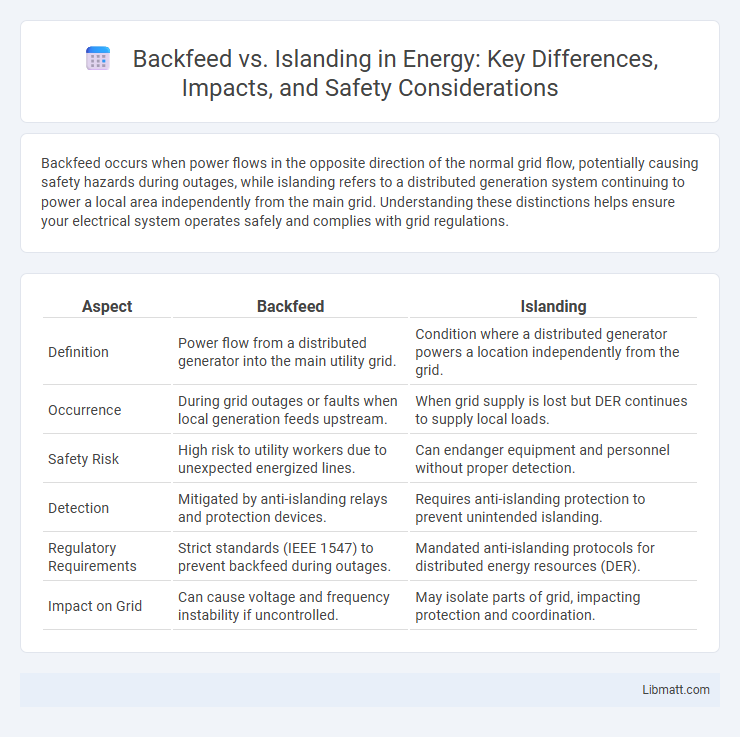Backfeed occurs when power flows in the opposite direction of the normal grid flow, potentially causing safety hazards during outages, while islanding refers to a distributed generation system continuing to power a local area independently from the main grid. Understanding these distinctions helps ensure your electrical system operates safely and complies with grid regulations.
Table of Comparison
| Aspect | Backfeed | Islanding |
|---|---|---|
| Definition | Power flow from a distributed generator into the main utility grid. | Condition where a distributed generator powers a location independently from the grid. |
| Occurrence | During grid outages or faults when local generation feeds upstream. | When grid supply is lost but DER continues to supply local loads. |
| Safety Risk | High risk to utility workers due to unexpected energized lines. | Can endanger equipment and personnel without proper detection. |
| Detection | Mitigated by anti-islanding relays and protection devices. | Requires anti-islanding protection to prevent unintended islanding. |
| Regulatory Requirements | Strict standards (IEEE 1547) to prevent backfeed during outages. | Mandated anti-islanding protocols for distributed energy resources (DER). |
| Impact on Grid | Can cause voltage and frequency instability if uncontrolled. | May isolate parts of grid, impacting protection and coordination. |
Introduction to Backfeed and Islanding
Backfeed occurs when electricity flows in the reverse direction from a distributed energy resource, such as a solar panel or generator, back into the utility grid. Islanding refers to a condition where a distributed generation system continues to power a local area despite being disconnected from the main utility grid. Both concepts are critical in grid safety and reliability, requiring sophisticated protection schemes to prevent equipment damage and ensure worker safety.
Understanding Electrical Backfeed
Electrical backfeed occurs when power flows in the opposite direction of its intended path, often from a distributed energy resource like solar panels back into the utility grid. This phenomenon can pose safety risks for utility workers and equipment if not properly managed, making detection crucial. Understanding backfeed is essential for designing effective anti-islanding protection that ensures your system safely disconnects during grid outages.
What is Islanding in Power Systems?
Islanding in power systems occurs when a distributed generator continues to power a localized section of the grid despite the main utility supply being disconnected, creating an independent "island." This condition poses safety risks, complicates grid protection, and can damage equipment due to uncoordinated voltage and frequency control. Effective detection and management techniques, such as anti-islanding protection, are essential to ensure system stability and personnel safety during outages or faults.
Causes of Backfeed in Electrical Grids
Backfeed in electrical grids occurs when power flows opposite to the normal direction, often caused by distributed energy resources like rooftop solar panels or backup generators feeding electricity back into the grid during outages. Improper switching, synchronization errors, or failure of protective devices can also lead to unintentional backfeeding, posing safety risks to utility workers and damaging equipment. Understanding these causes is essential for implementing effective anti-islanding protection and ensuring grid stability.
Common Scenarios Leading to Islanding
Common scenarios leading to islanding include a power outage on the main grid combined with distributed generation sources, such as solar panels or wind turbines, continuing to supply power to a localized area. Faults or maintenance activities that isolate a section of the grid without disconnecting distributed energy resources can create unintentional islanded operation. These situations pose safety risks to utility workers and can damage equipment due to the lack of synchronization with the main grid.
Safety Risks of Backfeed vs Islanding
Backfeed occurs when electrical power flows backward into the grid during a power outage, posing significant safety risks to utility workers by unexpectedly energizing lines. Islanding happens when a distributed generation system, like solar panels, continues to power a local area disconnected from the main grid, potentially endangering maintenance crews and damaging equipment due to uncoordinated power sources. Understanding these risks is critical for protecting personnel and ensuring that your electrical system incorporates proper anti-islanding and backfeed prevention technologies.
Detection and Prevention Methods
Backfeed detection relies on monitoring voltage and current anomalies using anti-islanding relays and reverse power relays to prevent unintentional power flow into the grid. Islanding detection methods often incorporate passive techniques such as voltage and frequency variation monitoring, while active methods use signal injection or impedance measurement to quickly identify loss of grid connection. Preventive strategies include coordinated inverter controls and protective relays that isolate distributed generation to maintain system stability and safety.
Impact on Utility Workers and Equipment
Backfeed occurs when electricity flows in the reverse direction, potentially energizing power lines unexpectedly, posing severe risks to utility workers who assume lines are de-energized during maintenance. Islanding happens when a distributed generator continues to power a local load after disconnection from the main grid, complicating safety protocols and damaging utility equipment due to uncoordinated power flows. Understanding these phenomena is crucial for protecting your safety and preventing equipment damage during grid outages or maintenance.
Regulatory Standards and Compliance
Backfeed and islanding are critical concepts in grid-tied photovoltaic systems, with regulatory standards such as IEEE 1547 and UL 1741 setting requirements for anti-islanding protection to ensure safety and reliability. Compliance mandates include accurate detection and prevention of unintentional islanding to protect utility workers and maintain grid stability. Your solar installation must adhere to these standards to meet local utility interconnection agreements and avoid costly penalties.
Future Trends in Grid Protection Technologies
Future trends in grid protection technologies emphasize advanced detection methods to distinguish backfeed from islanding events with higher accuracy, leveraging AI-driven algorithms and real-time data analytics. Innovations include adaptive relays and smart inverters that dynamically respond to grid conditions, enhancing safety and reliability as distributed energy resources grow. Your energy system will benefit from these developments through improved fault isolation and minimized downtime in increasingly complex grid environments.
Backfeed vs Islanding Infographic

 libmatt.com
libmatt.com